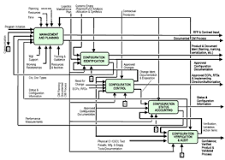The Importance of Configuration Management in IT
Configuration management is a crucial aspect of IT infrastructure that involves the process of managing and controlling changes to hardware, software, firmware, documentation, and other components throughout their lifecycle. It plays a vital role in ensuring the stability, security, and efficiency of IT systems within an organisation.
Benefits of Configuration Management:
- Consistency: By maintaining accurate records of configurations and standardising processes, configuration management helps ensure consistency across IT systems. This reduces errors and minimises downtime due to misconfigurations.
- Security: Proper configuration management practices enhance security by identifying vulnerabilities, ensuring compliance with security standards, and enabling swift responses to security incidents.
- Efficiency: Effective configuration management streamlines processes such as deployment, troubleshooting, and updates by providing a clear overview of system configurations. This leads to improved operational efficiency.
- Change Control: Configuration management facilitates change control by tracking modifications made to configurations over time. This helps prevent unauthorised changes and allows for better decision-making regarding system updates or upgrades.
- Auditability: Maintaining detailed records of configurations enables organisations to conduct audits more effectively. Auditing helps ensure compliance with regulations, identify areas for improvement, and track the impact of changes on system performance.
Best Practices for Configuration Management:
To maximise the benefits of configuration management, organisations should adhere to best practices such as:
- Documenting Configurations: Keep detailed records of hardware and software configurations, including version numbers, dependencies, and relationships between components.
- Implementing Change Control Procedures: Establish clear procedures for requesting, reviewing, approving, and implementing changes to configurations. Enforce strict controls to prevent unauthorised modifications.
- Automating Configuration Processes: Utilise automation tools to streamline configuration tasks such as provisioning new systems, deploying updates, and enforcing standard configurations across multiple devices.
- Regular Auditing and Review: Conduct regular audits of configurations to identify discrepancies or non-compliance issues. Review configuration data periodically to ensure accuracy and relevance.
- Training Staff: Provide training to IT staff on proper configuration management practices and tools. Promote awareness of the importance of maintaining accurate configurations for system reliability and security.
In conclusion, configuration management is an essential component of effective IT governance that contributes to the overall stability and security of organisational systems. By implementing robust configuration management practices and adhering to best standards in this area, businesses can enhance operational efficiency, mitigate risks, and maintain a competitive edge in today’s dynamic technological landscape.
Understanding Configuration Management: Key Stages, Pillars, Objectives, and Examples
- What are the 5 stages of the configuration management process?
- What are the 5 pillars of configuration management?
- What is the main objective of configuration management?
- What is an example of configuration management?
What are the 5 stages of the configuration management process?
The 5 stages of the configuration management process are crucial in ensuring the smooth operation and control of IT systems within an organisation. These stages typically include identification, planning, change control, status accounting, and auditing. Identification involves uniquely identifying configuration items and documenting their attributes. Planning focuses on establishing processes for managing configurations effectively. Change control is essential for tracking and approving modifications to configurations. Status accounting involves maintaining accurate records of configuration items and their current state. Lastly, auditing ensures compliance with standards and regulations while verifying the integrity of configurations. By following these stages diligently, organisations can maintain consistency, security, and efficiency in their IT environments.
What are the 5 pillars of configuration management?
One frequently asked question in the realm of configuration management is, “What are the 5 pillars of configuration management?” The 5 pillars of configuration management serve as foundational principles that guide the effective management of configurations within an IT environment. These pillars typically include aspects such as documentation of configurations, change control procedures, automation of configuration processes, regular auditing and review practices, and staff training on configuration management best practices. By understanding and implementing these pillars, organisations can establish a robust framework for maintaining system stability, security, and efficiency across their IT infrastructure.
What is the main objective of configuration management?
The main objective of configuration management is to establish and maintain consistency in the configuration of IT systems and components throughout their lifecycle. By documenting and controlling changes to hardware, software, and other elements, configuration management aims to ensure that systems operate reliably, securely, and efficiently. It enables organisations to track and manage configurations effectively, facilitating better decision-making, enhancing security measures, and supporting compliance with industry regulations. Ultimately, the primary goal of configuration management is to minimise risks associated with misconfigurations, improve system performance, and promote a structured approach to managing IT assets.
What is an example of configuration management?
An example of configuration management is the use of version control systems, such as Git, to manage and track changes to software code. In this scenario, developers can create different versions or branches of their codebase, allowing them to work on new features or bug fixes independently without affecting the main codebase. By using version control, teams can easily collaborate, review changes, revert to previous versions if needed, and maintain a well-documented history of modifications made to the code. This practice exemplifies how configuration management tools enable efficient and controlled management of configurations in a dynamic IT environment.

